The Colomba is a traditional Italian sweet Easter bread that’s deliciously fluffy and soft, filled with candied orange and topped with a roasted almonds and powdered sugar paste called glassa di mandorle.
This version of the recipe is gluten-free and low-carb, made with almond flour. It’s follows the same recipe steps of the original Italian classic dove bread, made with yeast and a slow, controlled rise.
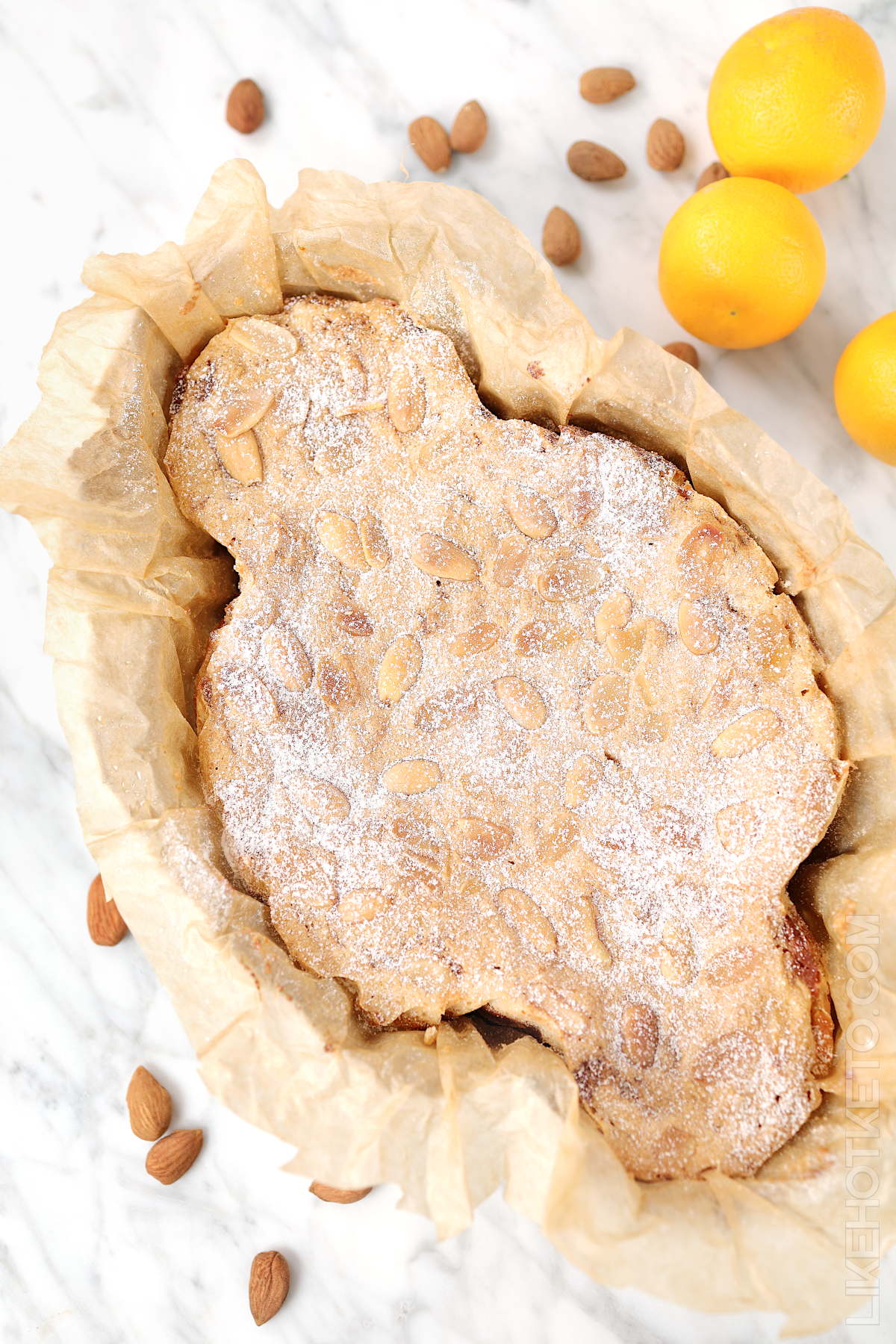
Most unfortunately, it’s impossible to just go out and buy a low-carb or keto-friendly version of this sweet Easter treat. At least there are some gluten-free colomba cakes available in stores, but they are incredibly hard to find. So I had to come up with a recipe to be able to enjoy my sweet colomba again!
It was hard work, I tell you. There were many attempts. I tried twice some time ago. I got it to taste good, but not spectacular. I gave up for a while, then recently I got possessed and baked 3 colomba cakes in 2 days, tweaking ingredients and methods until it was perfect!
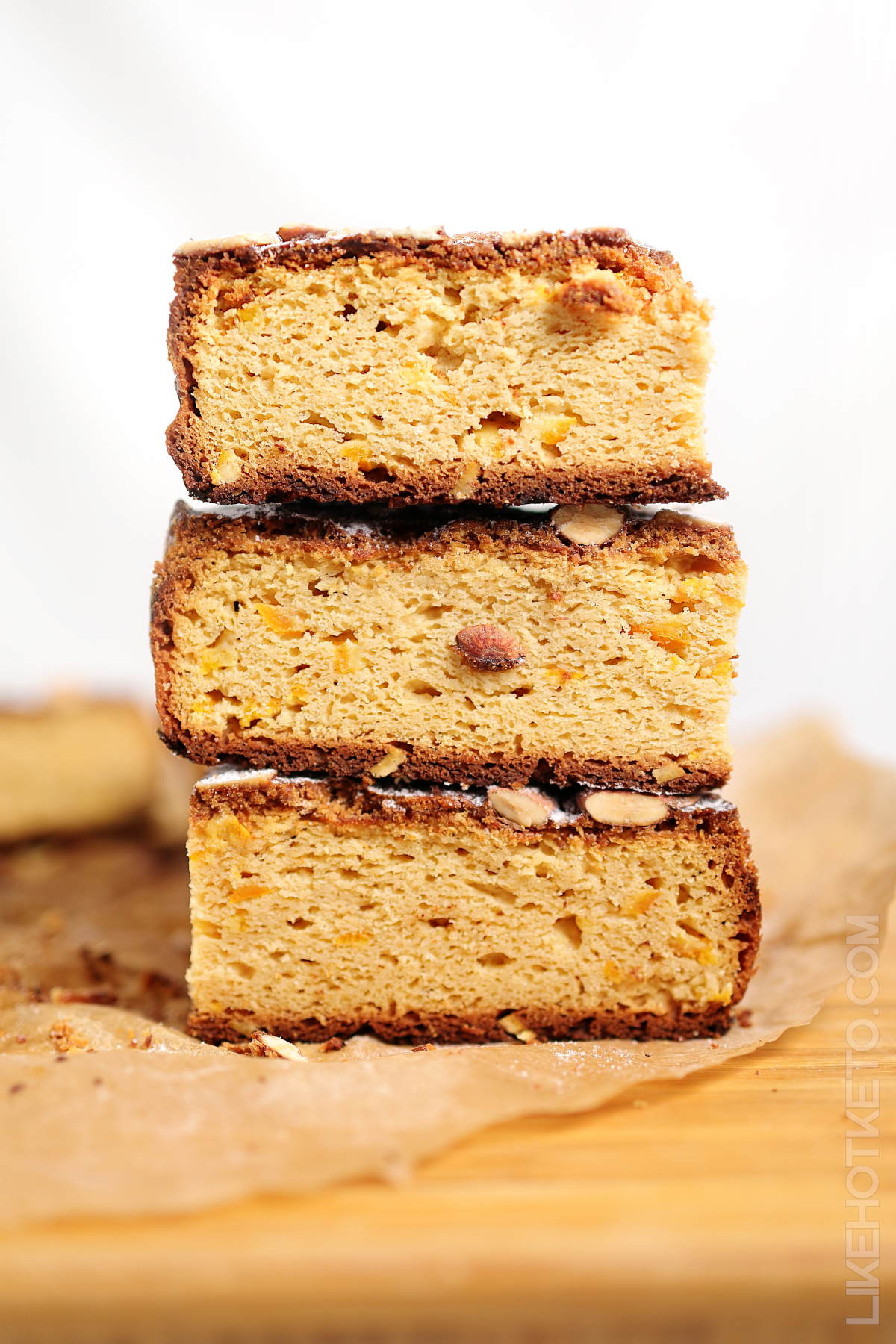
Ingredient notes
The ingredient list for la colomba was carefully tweaked to make this gluten-free and low-carb Easter cake taste as close to the Italian original as possible!
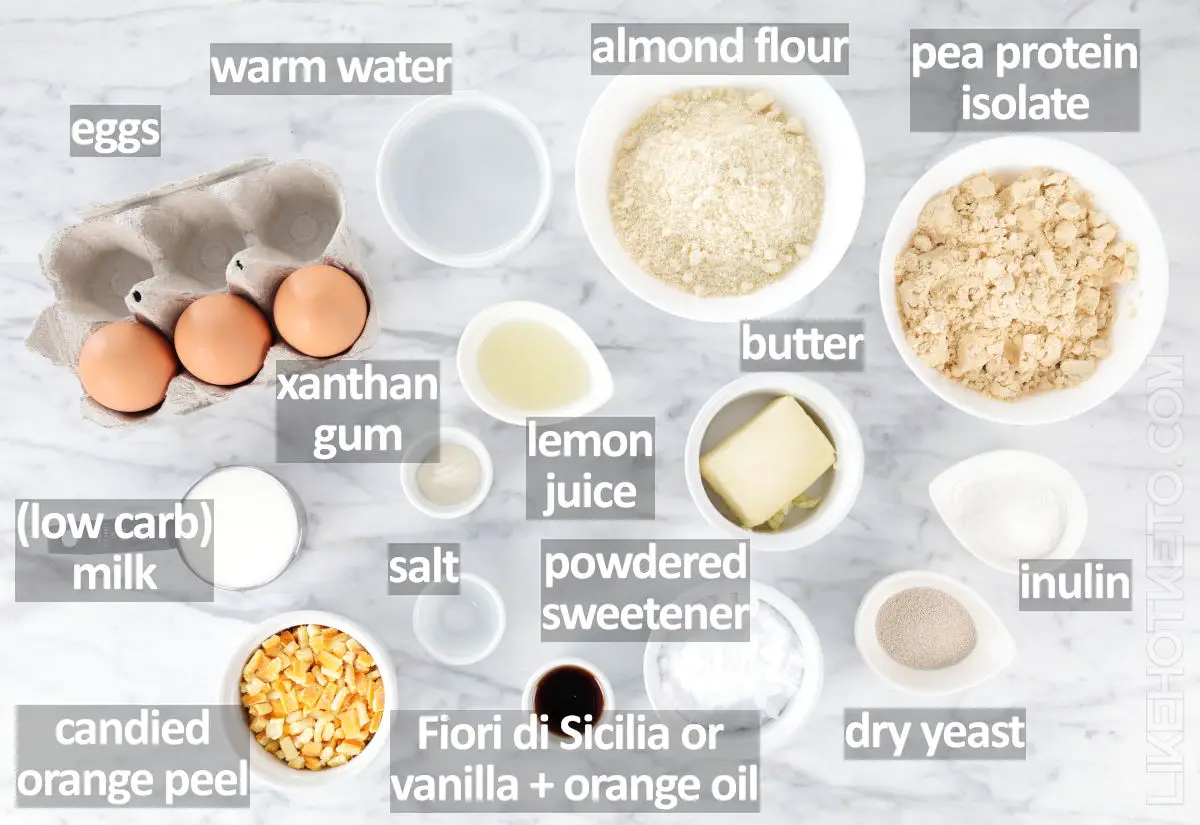
The keto flours: I used a combination of almond flour and pea protein isolate. High protein keto is my thing, so I try to bake with protein powders as much as possible – it’s really the best way to improve the macros in a recipe.
Pea protein isolate is my favorite protein powder for baking, as it doesn’t dry up the baked goods as much as whey protein. Still, going all in in pea protein can make cakes and bread a bit dense, so I used almond flour to lighten up the Easter colomba.
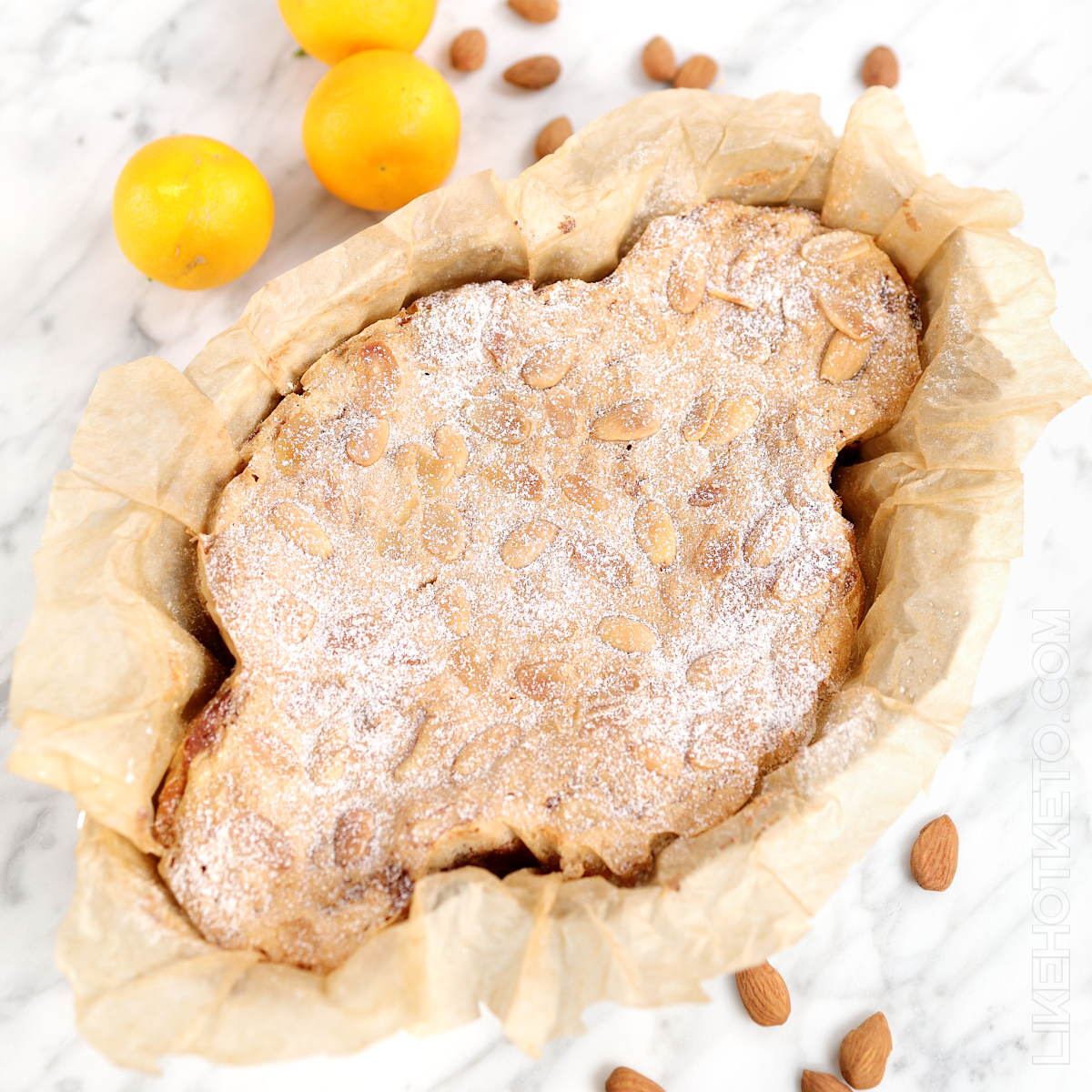
Powdered or confectioners sweetener: You can use powdered erythritol or allulose sweeteners, in blends with stevia or monk fruit for sweetness equal to that of real sugar. If using plain erythritol or allulose, the keto Easter bread it will be a little less sweet (that’s how I actually prefer).
Use the powdered, or confectioners version to ensure a better texture. If you have a granulated sweetener, you can powder it yourself by blending or processing it for a couple of seconds.
It’s important to note that allulose browns like sugar, while erythritol doesn’t brown at all.
To illustrate, compare the photos along this post, there’s two colomba cakes:

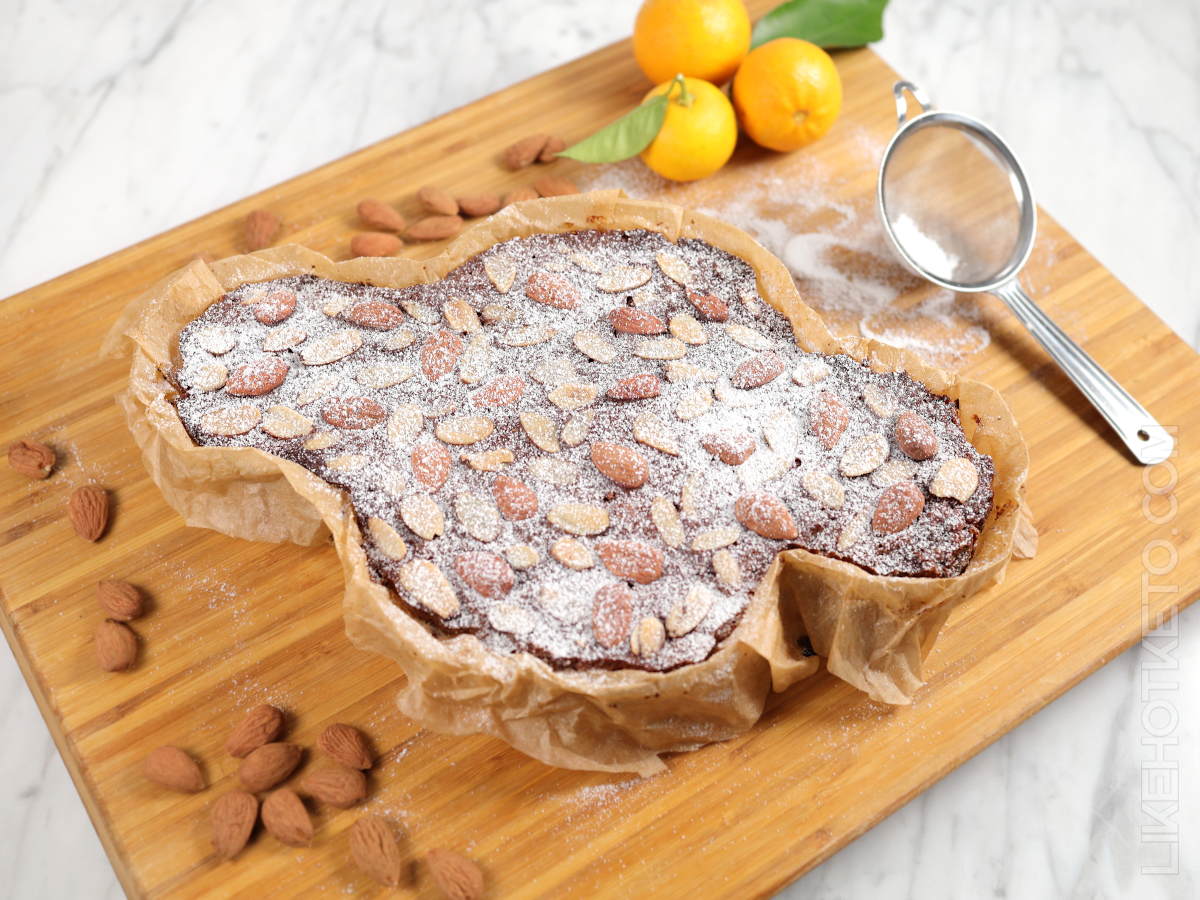
The one made with erythritol in the almond glaze is pale (I think it looks more delicate), and the one with allulose is a deep golden brown (which contrasts beautifully with the powdered sweetener on top).
Think of which look you like best on your keto Easter bread, they don’t really taste any different.
Eggs and butter: this is a super rich sweet Easter bread, so it takes eggs and some butter. I use grass-fed, unsalted butter for the best flavor and nutritional content. As the butter is melted in the microwave, there’s no need to first bring it to room temperature. But the eggs need to be left outside the fridge for a few hours before using them in the colomba recipe.
Xanthan gum: in the absence of gluten, this ingredient give elasticity to the dough and makes the sweet keto bread fluffy by helping trapping the air produced by the yeast inside.
Inulin: A mix of warm water, inulin and low-carb/nut milk (or just plain milk if not keto) helps quick start the yeast. The inulin helps by giving the yeast fuel for growth, as almond flour and pea protein don’t have sugar nor starch for it to feed upon.
Inulin can be difficult to find, but you can get it online. If you prefer, you can swap it for any natural sugar. Like honey, maple syrup, coconut sugar or cane sugar. The yeast will consume the sugars and produce the gas that will make the colomba bread grow, and there will be no carbs left in the recipe. Sweeteners cannot be substituted.
Lemon juice: Lemon juice makes the dough acidic which is the best environment to promote the yeast growth. It also lends some extra citrusy flavor to the keto Easter bread.
Flavors: Fiori di Sicilia lends this colomba the most irresistible aroma. This is an Italian specialty citrusy and flowery flavor made of essential oils that takes sweet breads and cakes to a whole new level.
Fiori di Sicilia varies in strength by brand and some are really potent, in which case you’ll need to adjust quantity to not overwhelm the recipe.
Can’t get your hands on Fiori di Sicilia? You can achieve a similar flavor by substituting it for a combination of vanilla extract and orange oil.
Candied orange peel: This is the most traditional filling for colomba. As it’s difficult to find a keto friendly, low-carb candied orange peel, I used my recipe for candied orange peel without sugar.
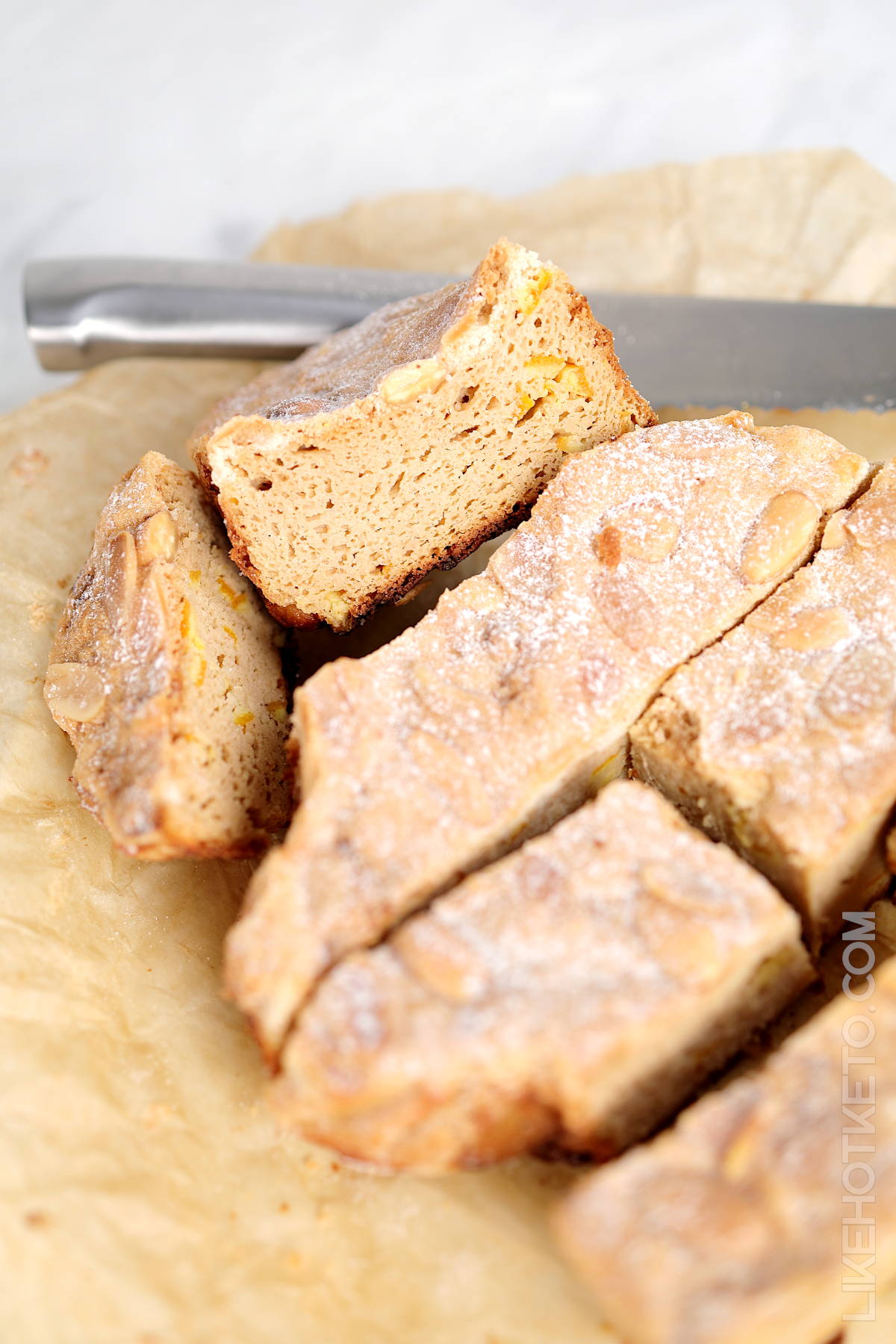
Make your own dove pan with foil
The colomba Easter cake is made in special paper pans that give it its traditional dove shape. Unfortunately, these paper molds are quite difficult to find outside Italy. I was surprised that a metal dove pan is available in the US. But it is quite an investment if you are not planning to bake colomba every other day.
You can totally bake the colomba on a regular pan, but where’s the fun in that? It’s super easy to make a dove shaped pan out of a simple foil pan, and you’ll get the classic colomba Easter bread to grace your table in all it’s dove shaped glory!
I used a disposable aluminum foil pan, 12 x 8 x 2 inch in size. It shouldn’t be a issue to use a slightly smaller or larger foil pan.
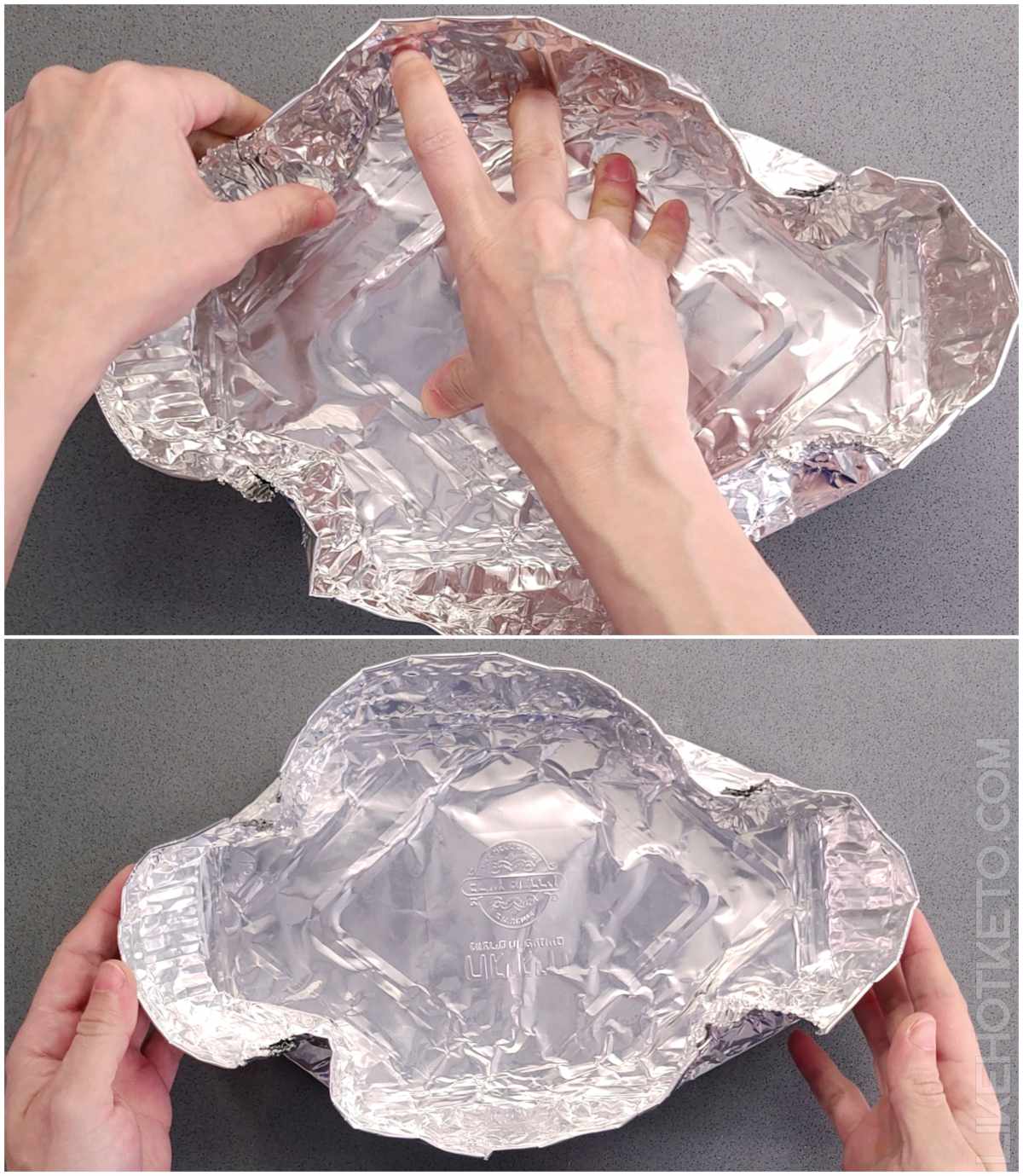
You can easily shape the foil pan into a dove directly with your hands. Fold the four corners in, and press the bottom part of the corners tightly to stop the colomba dough from going under there.
Alternatively, you can put a largish bowl in the center of the foil pan, and 2 small ones on the longer sides of the rectangle, and shape the foil against them. But I find that more complicated than free-styling.
Recipe directions
Time, as you’ll see, is the most challenging aspect of making the colomba yeasted cake. The hands-on recipe making is actually quite short and simple!
Start a few hours early, by removing the eggs from the fridge. It’s imperative to have them at room temperature, so that they don’t bring the yeast temperature down, which ruins their party and slows down the rising of the dough.
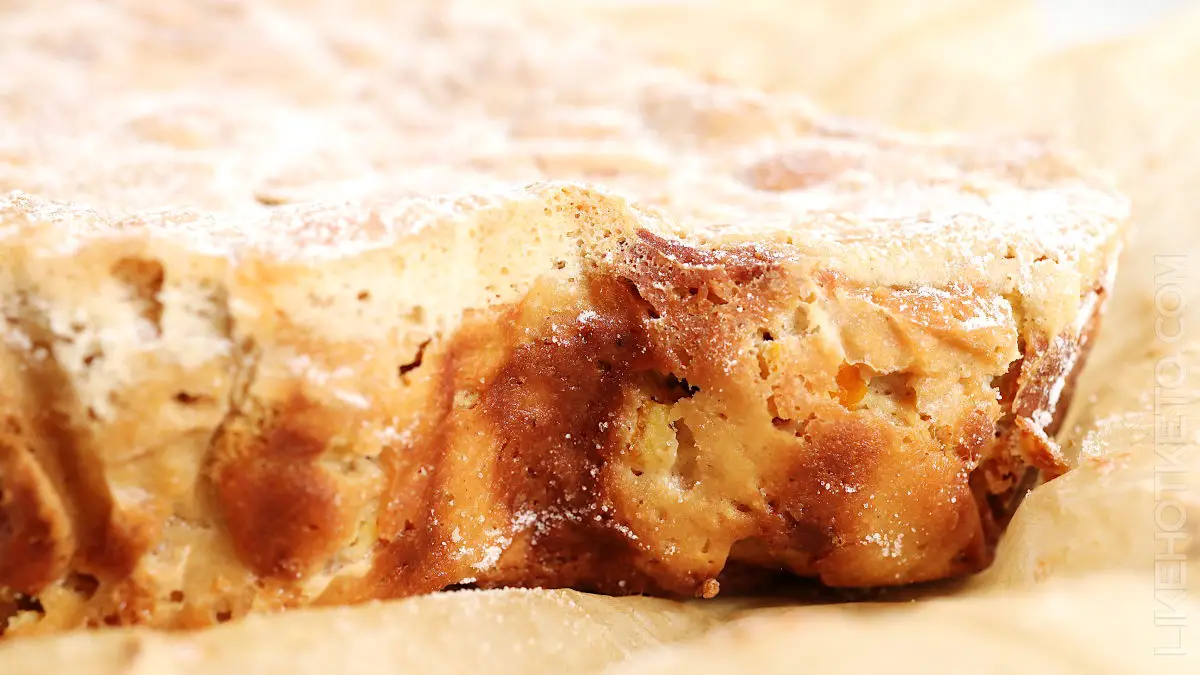
Line the baking pan
Get a piece of parchment paper that’s large enough to line the pan (whether you’re using a homemade/store bought colomba pan or a regular metal pan).
Wet the paper to make it soft and easier to shape. Then, arrange the paper over the pan, touching all along the bottom and tuck it in at the corners. Cut off the excess.
Spread a fine layer of olive oil all over the paper. For a metal pan, the work ends here.
If you are using a store bought colomba paper pan or a homemade aluminum foil pan (instead of a metal pan), there’s an extra optional step that can improve the texture of your keto Easter cake. Plus, it’s super cool to do:

Prepare the dove pan for hanging
This may sound a bit wild. But it’s a traditional thing that’s actually done in Italy when baking Easter colomba and Christmas panettone breads. When the colomba is finished baking, to avoid it collapsing and keeping it fluffy, you’ll hang it upside down. Trust the gravity, right?
Get 4 kebab sticks. These can be either metal or bamboo skewers. I used a couple of each to test if there was any difference, as as I imagined the steel ones could have a similar effect to heating rods. But the colomba baked evenly, so that wasn’t an issue.
The bamboo ones are just a bit more difficult to remove later on, but you only need to give them a couple of twists to loose them before pulling.
Now, grab your carefully prepared colomba dove pan. You’ll skewer it at four places, crossing all the way and exiting at the other side, close to the bottom of the pan but without touching. One stick going through the neck, one under the tail, and two across the belly. Like so:
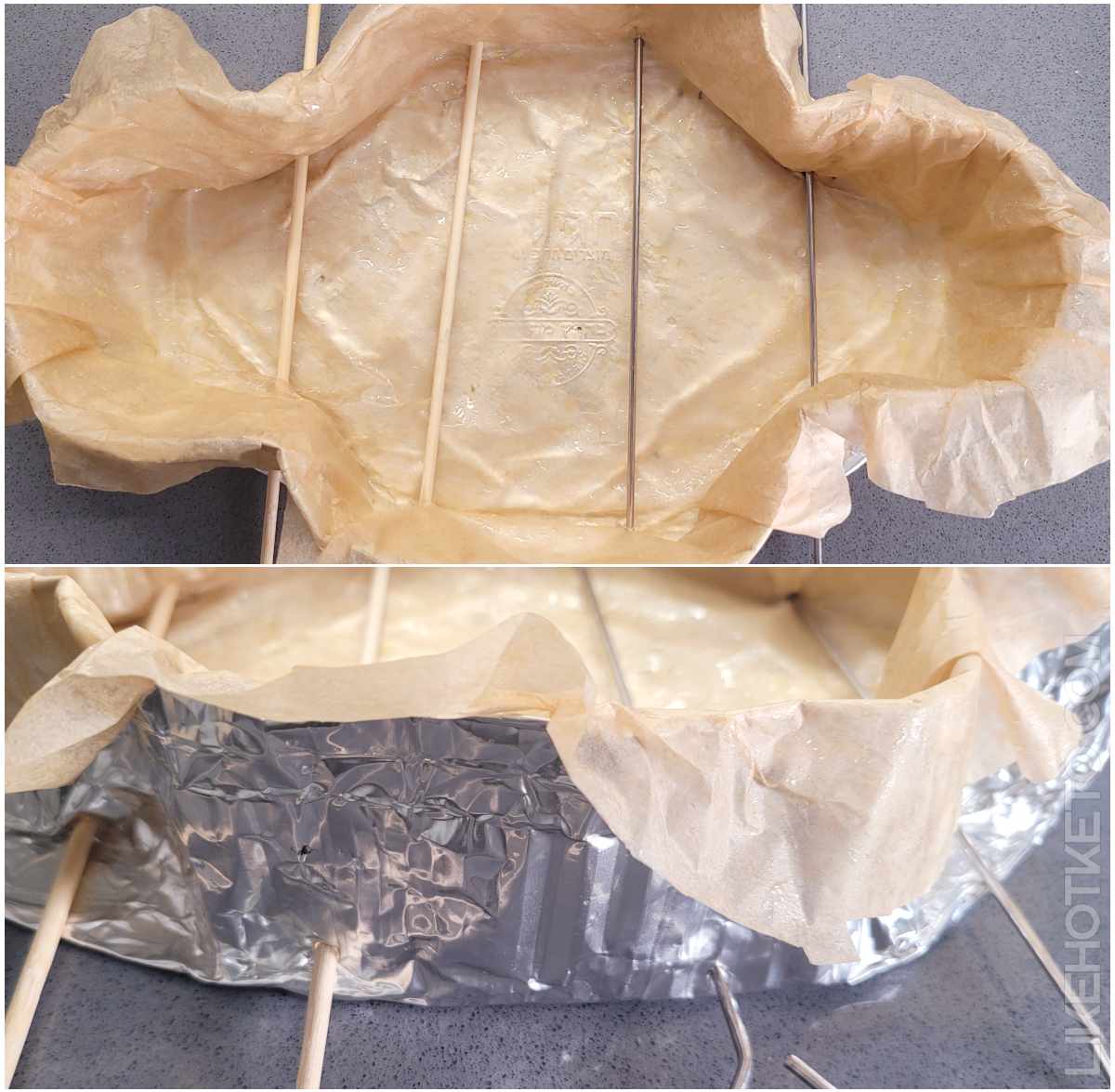
I said it was a bit wild.
Now it’s the best time to set up if you have the space, or at least figure it out, where and how you are going to hang the colomba for cooling down after baking it.
This should be done immediately as the keto Easter cake leaves the oven while still piping hot, so believe me you don’t want to be fumbling around with a steaming pan full of pointy sticks on your hands while looking for things that you can use to support it.
Find a few jars or bowls (or anything really) that are a couple of inches higher than the dove pan that you skewered. They should be even in height, so the colomba will be stable and not crooked.
Arrange these objects at about the distance from the pan where they will support the sticks, and turn the empty pan upside down between them. Check that all the skewers are supported and that the pan is level.
Now that you have your hanging area set up and tested, you can confidently turn your colomba upside down as soon as it finishes baking.
First kneading and rise
Mix well all of the dry ingredients for the colomba first kneading: almond flour, pea protein isolate, powdered sugar-free sweetener, salt, xanthan gum, inulin and instant dry yeast.
If using honey or maple syrup instead of inulin, add it to the egg mixture instead, together with the flavoring.
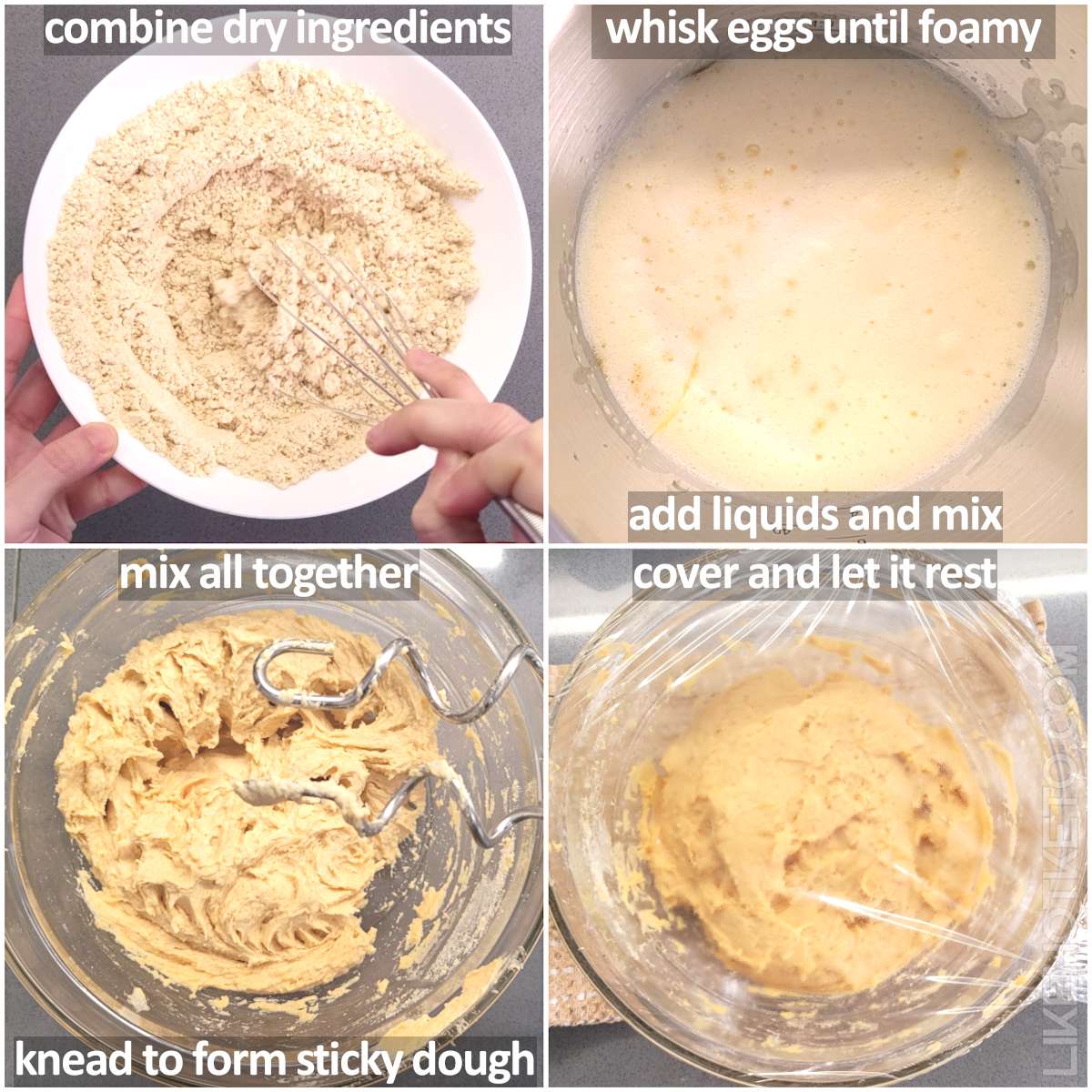
Separate one of the eggs, and keep the white reserved for the sugary almond topping. In a medium bowl, whisk the 2 remaining egg whites and the 3 yolks together until they are super foamy.
Add to the beaten eggs the Fiori di Sicilia flavoring or vanilla plus orange extract, lemon juice and warm water.
Add the dry ingredients to the egg mixture and mix gently on slow speed for about 4 minutes until it forms a smooth, sticky dough. With a standing mixer, use the paddle attachment. With a hand mixer, use the kneaders. You can also mix the dough by hand with a large spatula, it just takes a while.
Let the colomba dough rest, covered, for a couple of hours or until you can notice it’s just starting to puff up. This sort of preferment promotes better development of flavors and allows the gluten-free and low-carb flours (specially the pea protein) to fully hydrate and relax, in preparation to receive the remaining yeast soon.
Second kneading and final rise
Heat some milk and mix it with the keto friendly inulin in a small bowl. You can also use natural sugars, as I mentioned the yeast will consume them. Before adding the yeast, make sure the mixture is just warm (not too hot or cold).
If you have a thermometer, the mix should be at 40°- 46° C (105° to 115° F). Heat makes yeast start working faster, but too much of it will kill it. Then cover the bowl and keep it in a warm place away from draft.
Heat the butter in the microwave until just melted.
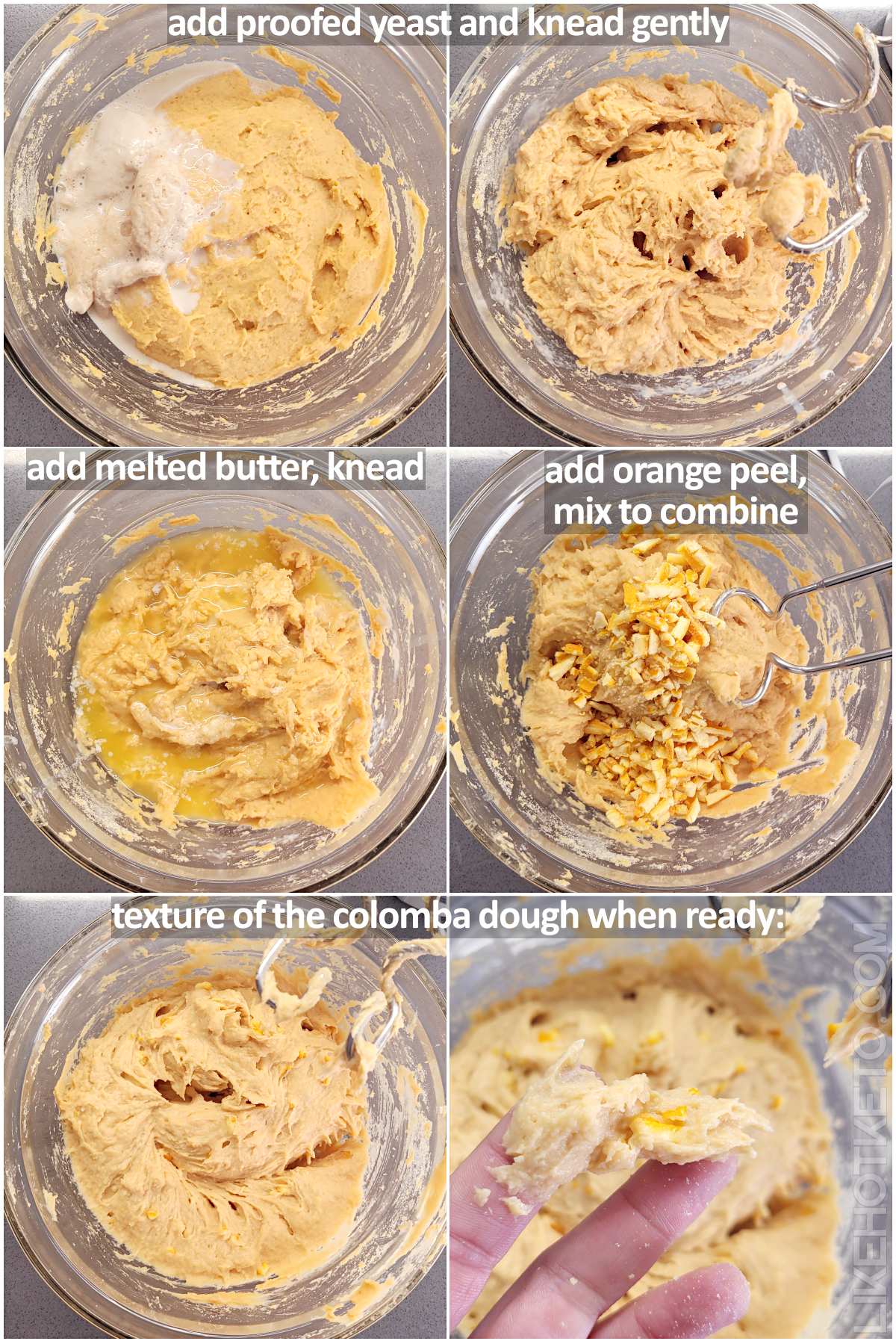
Give the yeast a few minutes to wake up, and come back to it after preparing the next steps. You should find that the mixture is bubbly and hopefully doubled in size (not lazy ones!). If the mixture hasn’t changed, something is wrong with the yeast. Discard everything and try again with a new pack.
Add in the yeast mixture, and knead slowly and gently for about 3 minutes. Then, add the melted butter and mix for about 2 minutes more, until it’s fully incorporated.
At last, fold in the fillings. I used chopped candied orange peels (sugar-free for keto) as it’s traditional in Italian colomba, but sugar-free chocolate chips or cranberries are nice, too.
Transfer to pan and level
Now you can transfer the colomba dough to the prepared pan. The dough is thick and very sticky, but not hard. Spread it gently filling all corners of the pan, then smooth out the top:
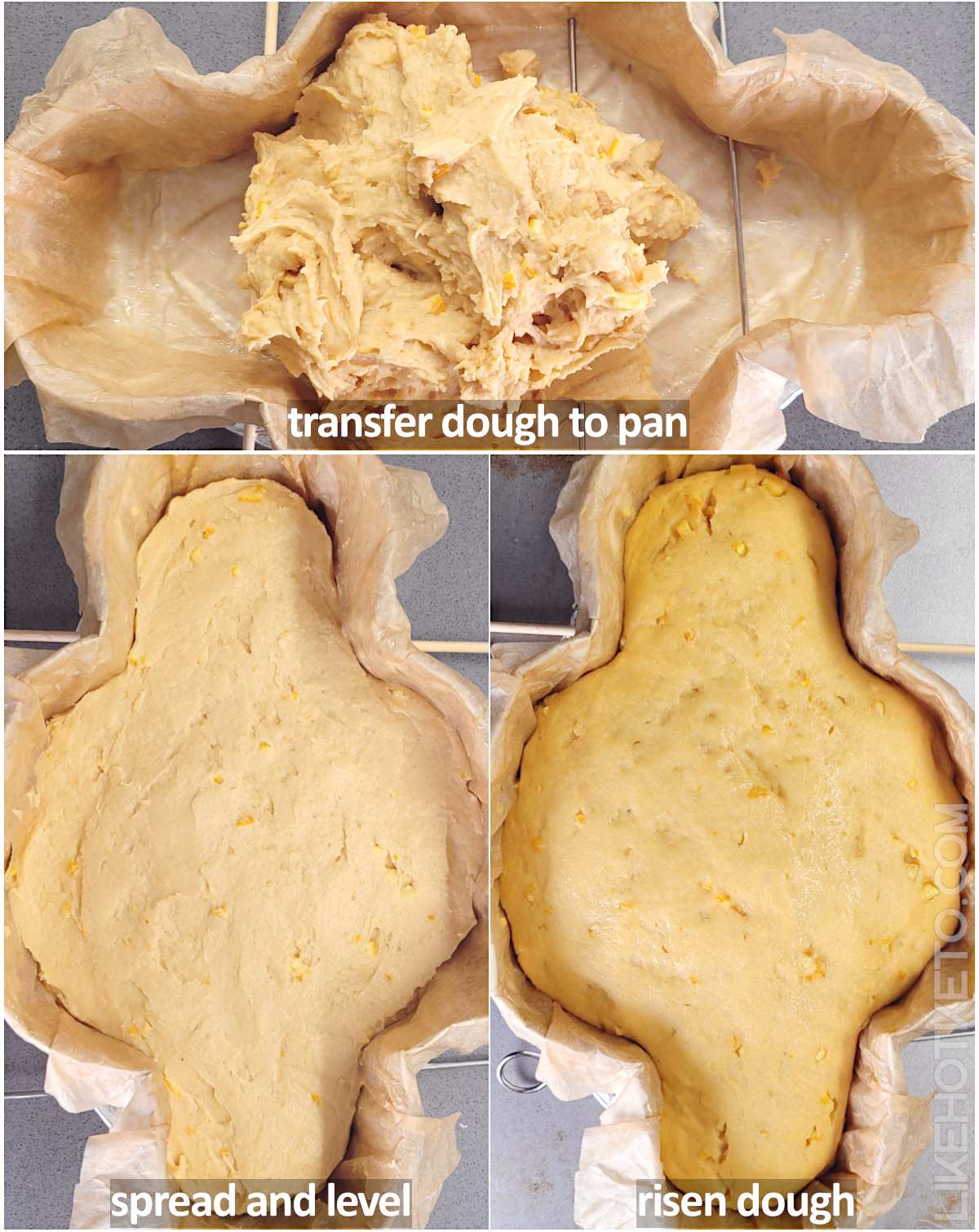
To prevent the top of the colomba from drying, you can put an oiled piece of parchment paper touching the entire surface of the dough, or just apply some olive oil gently with your fingertips, then cover the pan with cling wrap or a cloth towel.
Rising the dough
Now the waiting game begins. Depending on your kitchen temperature, this might take a while. Keto and gluten-free dough is heavier and requires a little extra warmth and patience. In a summer day it could take about 2 or 3 hours.
My last recipe took 7. Mind you, it’s winter and I don’t have heating, so it’s rather chilly inside. I put the colomba in the oven with the light on, which helped provide the yeast a bit of warmth.
Anyway, please don’t worry if it’s taking too long – I also get disheartened by lazy yeast! If the yeast is alive (and you proved it is by proofing), it will multiply. And, the longer it takes, the better it tastes 🙂
Add glaze and toppings
When the colomba is all puffed up and risen to about 1.5 times in size (it doesn’t normally double in size like regular gluten bread), start heating up the oven to 160 °C (320 °F) and making the glassa di mandorle, or almond glaze.
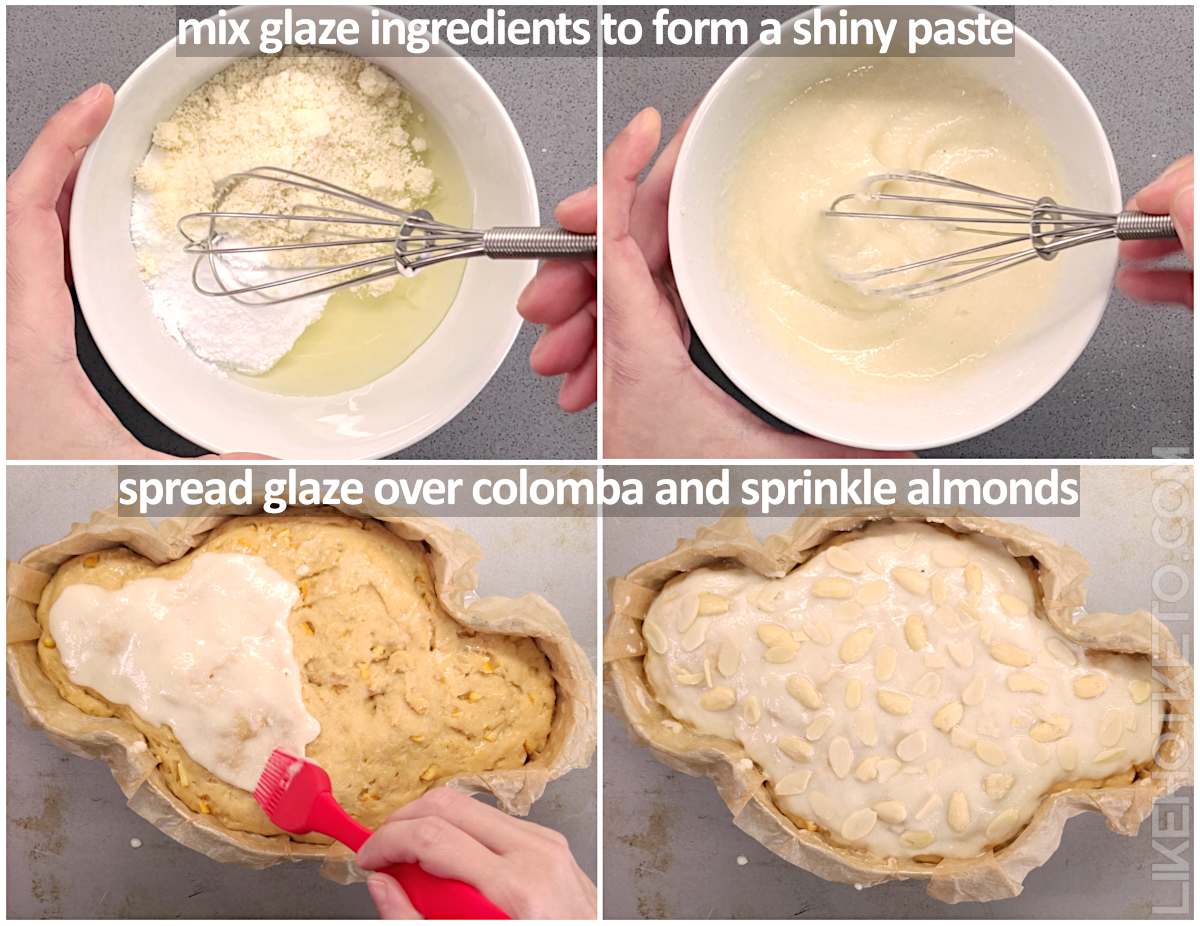
Take the reserved egg white and add powdered erythritol or allulose and almond flour, then mix briskly with a small whisk or a fork until it forms a smooth shiny paste.
Gently apply the glassa di mandorle all over the colomba. Don’t worry too much about hitting every little corner, as the mix will melt and spread out a bit as it heats in the oven.
Then, sprinkle the colomba cake with almonds. You can use whole almonds, sliced or shaved, or a mix of them all.
Baking and cooling
Bake the gluten-free colomba in the fully preheated oven for about 1 hour and 15-20 minutes.
To make sure it’s fully baked, use a thermometer. The temperature right inside the middle of the bread (don’t touch the bottom of the pan) should read at least 99 °C (210 °F).
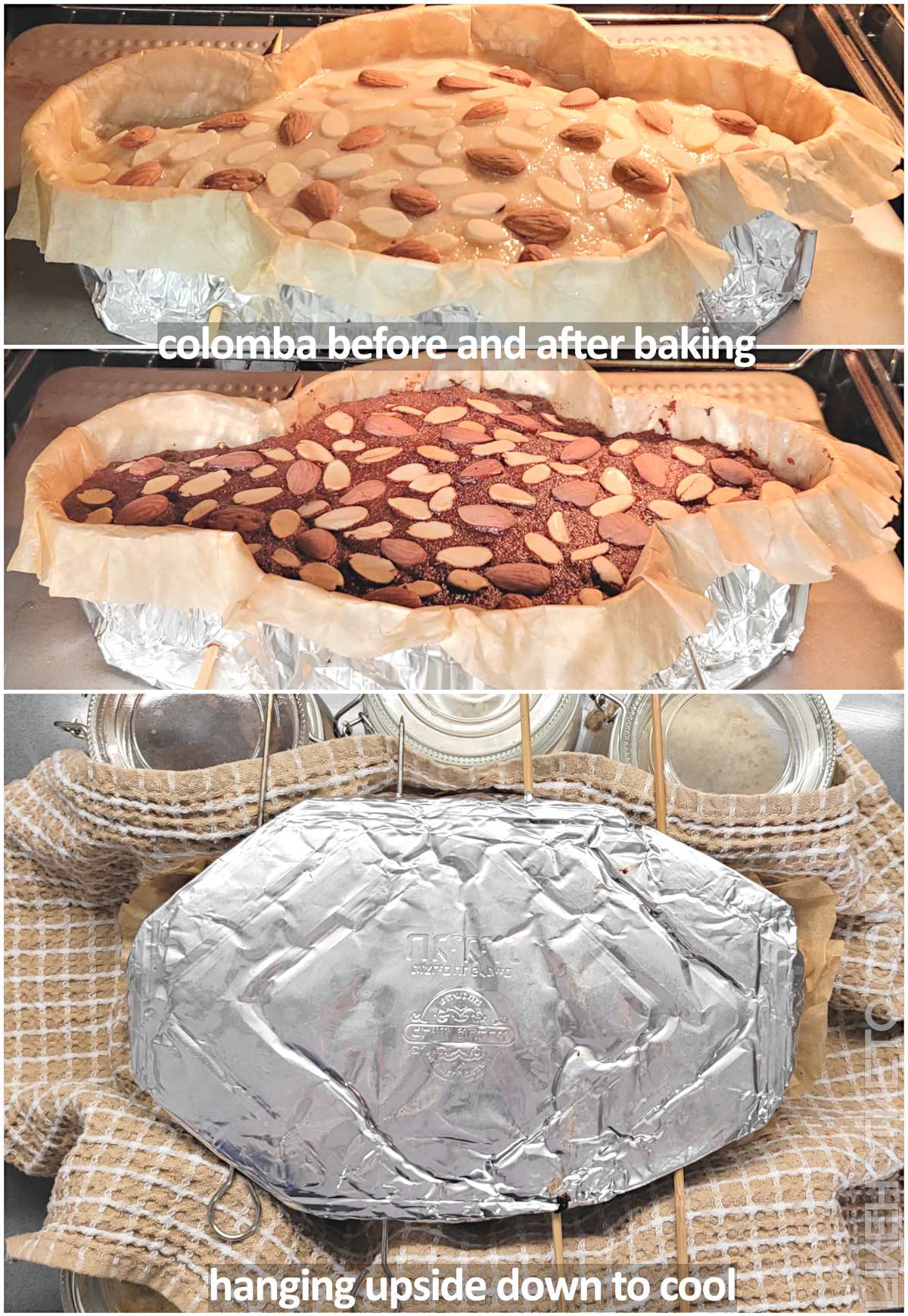
When you turn off the oven, either leave the colomba inside with the door cracked open slightly until it’s fully cooled down, or hang the sweet bread upside down to cool.
If you decided to hang the colomba upside down to cool, prepare the spot to do it in advance of switching off the oven. The Easter cake has to be inverted immediately when the baking time finishes.
Wait until it’s fully cooled before slicing
Wait until la colomba is FULLY cooled down before slicing it. It will take a few HOURS. But yes, after all this work you definitely need to! This is the reason why:
If you cut into a hot/warm gluten-free colomba, you allow for the swap of the hot steam inside the bread with the cold air outside, stopping the residual cooking and making it become heavy and gummy.
Yeah, horror movie style! Just be patient, it will be tastier and fluffier the longer you wait!
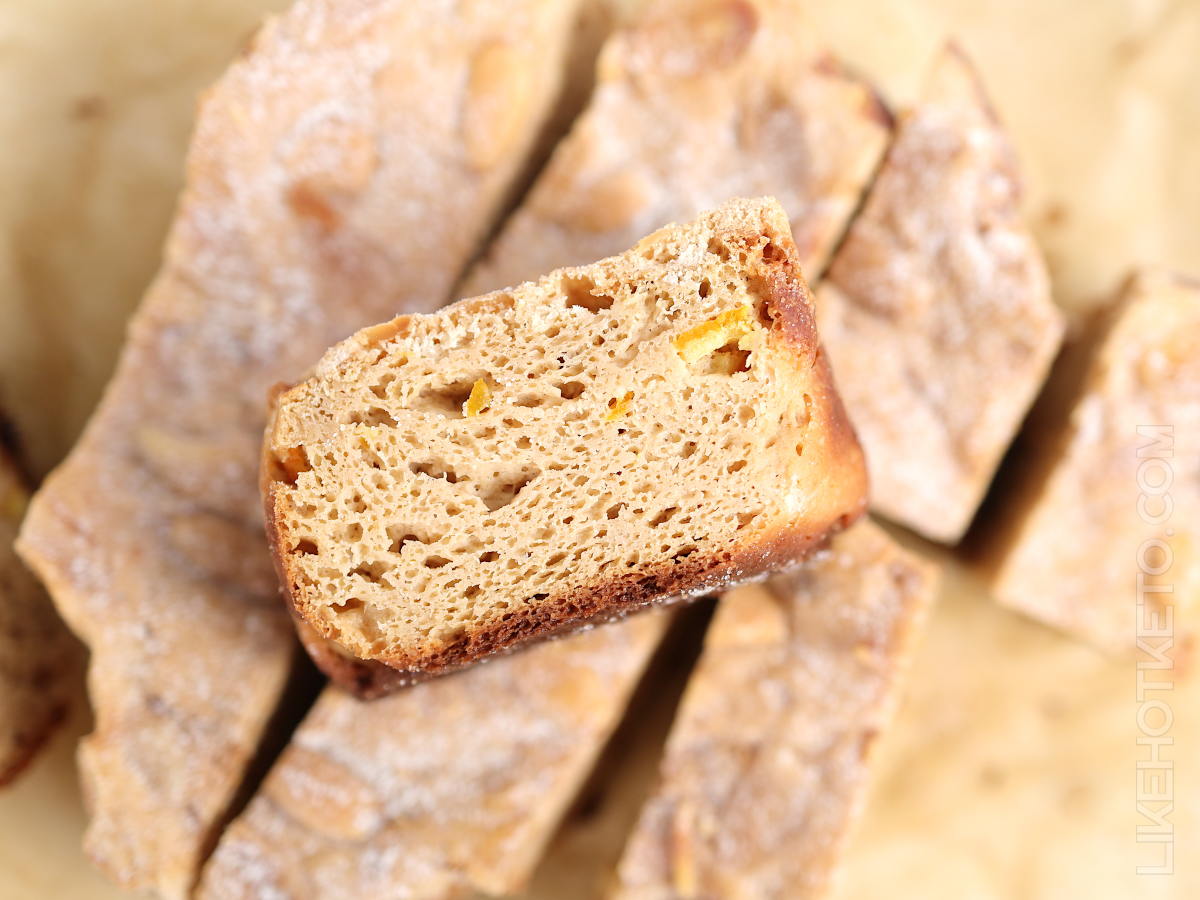
Variations
One of the great things about making a Colomba at home is that you can customize the recipe to suit your tastes. You can add more or less candied fruit, nuts, or other flavorings to make the bread just the way you like it. Here’s some ideas:
- Chocolate Colomba: Instead of the candied oranges, just mix in chocolate chips or chunks for a decadent twist on the classic Colomba.
- Lemon and Blueberry Colomba: Fold in fresh or frozen (but fully thawed) blueberries and lemon zest to the dough for a tangy and fruity Colomba. You can also add a lemon glaze on top for extra flavor.
- Pistachio and Cranberry Colomba: Mix in chopped pistachios and dried (sugar-free) cranberries to the dough for a nutty and fruity Colomba. Drizzle with keto white chocolate or sprinkle with powdered sweetener for a festive touch!
FAQ
What is colomba bread (or cake?)
La Colomba di Pasqua is an Italian Easter cake, or technically a bread, as it’s yeast risen. It is a traditional Easter dessert that is similar to the more well-known Italian bread, the Christmas panettone. The most striking difference is the shape: the colomba is shaped like a flying dove (colomba means “dove” in Italian).
What does it taste like?
Colomba di Pasqua is a sweet and rich bread, fluffy and with a delicious citrusy aroma. In its typical not keto or gluten-free version, colomba is usually made with flour, sugar, eggs, butter, and candied orange peel, and is topped with pearl sugar and almonds.
If you ever had panettone or pandoro, the Italian Christmas cakes, you have a very good idea of how colomba tastes like. The three sweet breads have nearly the same ingredients and are all quite similar in terms of texture and taste, except for the fillings and toppings.
The history of the dove shaped bread
Colomba di Pasqua was created in the early 1900s by the Italian baker Angelo Motta. He was looking for a way to use the same recipe for his popular panettone to create a similar Easter bread. (Entrepreneurship: why change what’s working, right?)
He came up with the idea of shaping the bread like a dove and topping it with pearl sugar and almonds, and Colomba di Pasqua was born!
Today, Colomba di Pasqua is a beloved Italian Easter tradition and is enjoyed by people all over the world. It is often given as a gift during the Easter season and is enjoyed as a dessert or snack with friends and family.
Its light and airy texture and sweet, nutty flavor make it a perfect complement to a cup of coffee or tea, and its dove shape serves as a reminder of the hope and peace that Easter represents.
Storage and freezing
The baked keto colomba, once fully cooled, should be stored in an airtight plastic bag to avoid it from drying out. You can keep it at room temperature, for up to 3-4 days.
The colomba di Pasqua can also be frozen, for up to two months. Put it in a freezer safe bag or airtight container.
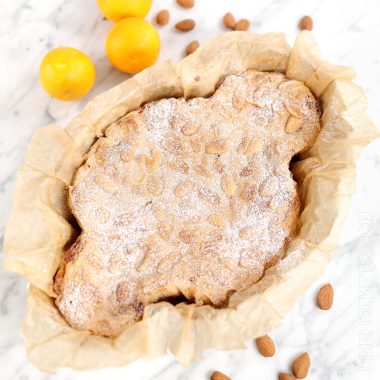
Italian Easter Dove Bread (Colomba di Pasqua)
Ingredients
First kneading
- 1 cup (100 g) almond flour
- 1 cup (110 g) pea protein
- ½ teaspoon instant dry yeast
- ½ cup (96 g) powdered sweetener See notes
- 2 teaspoons inulin See notes for substitutes
- 1 teaspoon xanthan gum
- ¼ teaspoon fine salt
- 2 egg whites room temperature (save third egg white for the glaze)
- 3 egg yolks
- ½ teaspoon Fiori di Sicilia flavoring or 1 1/2 teaspoon vanilla extract plus 1/2 teaspoon orange oil
- 2 tablespoons lemon juice
- ⅓ cup (80 ml) warm water
Second kneading
- 2 tablespoons low-carb milk
- 1 teaspoon inulin
- 1 teaspoon instant dry yeast
- 4 tablespoons (56 g) unsalted butter melted
- ½ cup (76 g) sugar-free candied orange peel chopped
Glaze and topping
- 1 egg white (reserved from dough)
- 4 tablespoons (40 g) powdered sweetener
- 3 tablespoons (22 g) almond flour
- ¼ cup whole almonds and/or sliced almonds
Instructions
- Before starting, please see instructions in the post above if you wish to make your own special baking pan for colomba bread with foil, or learn the optional method of hanging the bread upside down to cool.
First kneading
- Add all of the dry ingredients in the first kneading section to a large bowl: 1 cup almond flour, 1 cup pea protein, 1/2 cup powdered sweetener, 1/2 cup powdered sweetener, 2 teaspoons inulin, 1 teaspoon xanthan gum and 1/4 teaspoon fine salt. Whisk together to fully combine and fluff it up.
- Separate one of the eggs, and reserve the white for making the glaze later on. In the standing mixer bowl (if using) or a large bowl, whisk the 2 egg whites and the 3 egg yolks together until very foamy. If using a standing mixer, use the whisk attachment and mix at medium-high speed for about 3 minutes.
- Add 1/2 teaspoon Fiori di Sicilia flavoring, 2 tablespoons lemon juice and 1/3 cup warm water and mix just to combine.
- If using a stand mixer, switch now to the paddle attachment. If using a hand mixer, use the kneaders. Or a large spatula if mixing by hand.
- Add the whisked dry ingredients to the egg mixture and mix gently on slow speed for about 4 minutes until it forms a smooth, very sticky dough.
- Cover the bowl with cling wrap or a cloth and let the dough rest for a couple of hours or until you notice it's puffed up. After this time, proceed with the following steps.
Second kneading
- Add 2 tablespoons low-carb milk to a small bowl and heat it until warm – about 40°- 46° C (105° to 115° F). Mix in 1 teaspoon inulin and 1 teaspoon instant dry yeast. Cover the bowl and keep it in a warm place for a few minutes.
- Add the yeast and milk mix to the colomba dough, and gently knead on slow speed for about 3 minutes.
- Heat 4 tablespoons unsalted butter until just melted. Pour onto the dough and mix for a couple more minutes, until it's fully incorporated.
- Mix in the chopped 1/2 cup sugar-free candied orange peel filling.
- Transfer dough to a pan lined with oiled parchment paper. The dough is thick and very sticky, but not hard. Spread it gently filling all corners of the pan, then smooth out the top with a spatula or wet fingers.
- Put an oiled piece of parchment paper touching the entire surface of the dough, or apply some olive oil gently with your fingertips to prevent the top of the colomba from drying and cracking. Cover the pan with cling wrap or a cloth towel and keep it in a warm place until it's puffed up to about 1.5 times in size. It will take about 2-3 hours in a warm environment, longer if it's cool.
- When colomba is nearly risen, start preheating oven to 160 °C (320 °F).
Almond glaze
- Prepare the glaze by mixing 1 egg white, 4 tablespoons powdered sweetener and 3 tablespoons almond flour with a fork or small whisk to form a shiny paste.
- With a gentle touch, apply the sweet glaze all over the risen colomba dough. There's no need to hit every corner as it will spread as it warms up in the oven. Sprinkle 1/4 cup whole almonds or almond slices as desired.
- If using a aluminum foil or paper pan, slide it onto a baking sheet before taking into the oven.
- Bake the colomba at 160 °C (320 °F) for about 1 hour 15 minutes. The colomba might seem too brown before the end of baking time, specially if using allulose sweetener, but don't assume that it's ready. You can prevent too much browning with a foil tent if needed. The colomba will be fully baked when the temperature in the middle of the bread reads at least 99 °C (210 °F).
- When you turn off the oven, either leave the colomba inside with the door cracked open slightly until it's fully cooled down, or remove immediately from the oven and hang it upside down to cool (if you prepared for it in advance as per instructions).
- Wait until the colomba is fully cooled (a few hours at least) before slicing it.
Notes
Nutrition
Copyright Pris Frank for LikeHotKeto. Please DO NOT SCREENSHOT OR COPY/PASTE recipes to social media or websites. We’d LOVE for you to share a link to this recipe instead 🙂 Try the easy sharing buttons below!
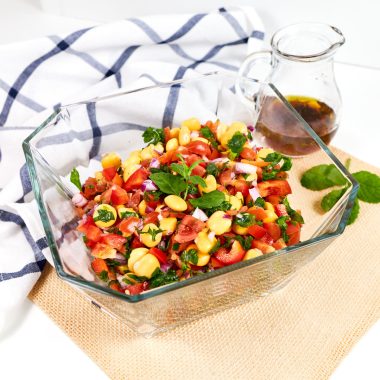
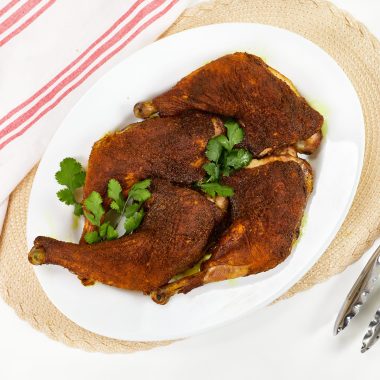


I’m glad you loved it Janett!
This was AMAZING!!! Reminds of panettone flavor a lot, and I LOVE panettone! Thank you so much for making it keto, that’s a flavor I really missed.